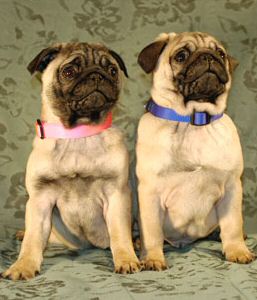Pug

 This old breed is thought to had been developed in 400 B.C. China from miniaturized mastiffs, known as Pai dogs. Some believe that the Pug is simply a short-coated variety of its cousin, the Pekingese, which is also descended from the ancient Pai. A popular pet of Chinese royalty and a sacred companion in the Tibetan monasteries, the Pai Dog was introduced to Holland in the 1500's where it became a favourite companion of European aristocracy. It could be argued that the Pug is actually an European creation, because it looks quite different than its ancestor, the Chinese Pai Dog. When the Pug was introduced to Britain, it became so popular that it influenced some strains of smaller bulldogges, eventually leading to the creation of the modern breed today known as the English Bulldog. Nearly vanishing in the 1800's, its immense popularity in America during the 20th century guaranteed the Pug's survival and this beautiful little dog is now a well-loved and common family pet all over the world. On top of being an important ingredient in the development of some historic Molossers, its appeal also proved to be a foundation for the creation of many modern small companion breeds, such as the Miniature Rottweiler, the Bullpug, the Lo-Sze Pugg, the Bug and others.
This old breed is thought to had been developed in 400 B.C. China from miniaturized mastiffs, known as Pai dogs. Some believe that the Pug is simply a short-coated variety of its cousin, the Pekingese, which is also descended from the ancient Pai. A popular pet of Chinese royalty and a sacred companion in the Tibetan monasteries, the Pai Dog was introduced to Holland in the 1500's where it became a favourite companion of European aristocracy. It could be argued that the Pug is actually an European creation, because it looks quite different than its ancestor, the Chinese Pai Dog. When the Pug was introduced to Britain, it became so popular that it influenced some strains of smaller bulldogges, eventually leading to the creation of the modern breed today known as the English Bulldog. Nearly vanishing in the 1800's, its immense popularity in America during the 20th century guaranteed the Pug's survival and this beautiful little dog is now a well-loved and common family pet all over the world. On top of being an important ingredient in the development of some historic Molossers, its appeal also proved to be a foundation for the creation of many modern small companion breeds, such as the Miniature Rottweiler, the Bullpug, the Lo-Sze Pugg, the Bug and others.

 A charming dog, the Pug makes a wonderful companion, loving of its owner and gentle with children. This is a very intelligent and intuitive Molosser, usually responsive to obedience training, but sometimes fairly stubborn and undemonstrative. Some specimens are quite feisty and can be unfriendly towards other dogs, but the Pug is generally a relaxed and even-tempered pet. The body is stocky and muscular, with a very short neck and a round, short-muzzled head. The skin is moderately wrinkled and flexible, especially on the face, which has fairly large and expressive eyes. The tail is tightly curled over the dog's back.
A charming dog, the Pug makes a wonderful companion, loving of its owner and gentle with children. This is a very intelligent and intuitive Molosser, usually responsive to obedience training, but sometimes fairly stubborn and undemonstrative. Some specimens are quite feisty and can be unfriendly towards other dogs, but the Pug is generally a relaxed and even-tempered pet. The body is stocky and muscular, with a very short neck and a round, short-muzzled head. The skin is moderately wrinkled and flexible, especially on the face, which has fairly large and expressive eyes. The tail is tightly curled over the dog's back.
The coat is short and smooth, coming in solid colours of fawn, silver, apricot and black. Light-coloured examples have black masks covering the muzzle, eyes and ears. Some specimens even have a black line on the back, extending from the head to the tail. The average height is 10 inches.
